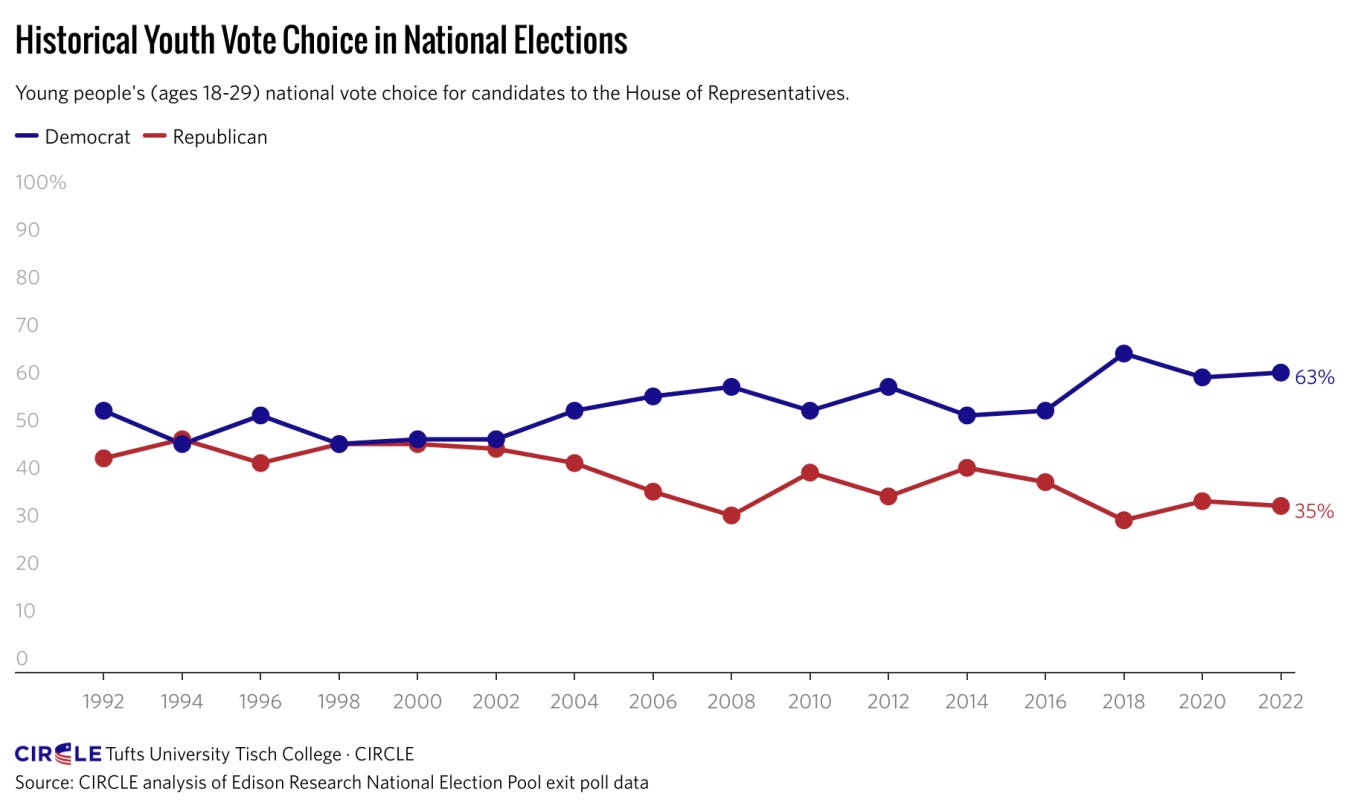4 Steps the GOP Can Take to Start Winning Back the Youth Vote in 2024 (and beyond…)
Republicans have their work cut out for them if they want to cut into the Democrats’ advantage with young voters. Here are 4 steps the party can take to get started in that endeavor moving forward.
It’s no secret that the Republican Party has been struggling to win over younger voters (Millennials and Gen Z) for years.
After all, the GOP’s youth problem started long before the rise of Donald J. Trump. Not since George W. Bush was in office have the two parties split the youth vote, according to researchers from CIRCLE at Tufts University in Massachusetts.
What CIRCLE’s research shows, however, is the gap between Republicans and Democrats has gotten substantially wider over the last decade — to the point where voters under the age of 30 are voting nearly 2:1 for Democrats in recent elections.
Why is this all happening?
Unfortunately, a perfect storm of events has come together to result in the sharp change in voter preference among Millennials and Gen Z adults over the last 20 years.
The first is the GOP’s positioning on social and cultural issues. No longer is the GOP the “Big Tent Party” featuring leaders like the late Sen. Arlen Specter (PA) and Sen. Lincoln Chafee (RI). Republicans have instead pushed in recent years to restrict abortion access nationwide, as well as for restrictions affecting those in the LGBTQ+ communities.
Along those lines, the GOP’s continued allegiance with former President Donald Trump continues to hurt the party with younger voters. As you can see in the above graph (CIRCLE), Republicans had made inroads with Millennials in 2014 — coming within 10 points of Democrats on the Congressional ballot that year — before permanently losing the cohort once the Don rode his infamous escalator that fateful day in June 2015. Whether it’s his polarizing personality, presidential track record, or positions on key issues such as immigration, healthcare, and climate, change, many young voters are skeptical of another four years under Trump.
Lastly, the Republican Party’s current messaging hasn’t done it any favors with younger voters. Continuing on from the Trump years, the GOP’s message is often perceived as negative and divisive to younger Americans — and as a result, it does not resonate with them very well. Younger voters are more likely to seek out a political party/ideology that offers solutions to the issues/problems they care about, not just critiques.
What now?
Sadly, Republicans have their work cut out for them if they want to make a dent in the Democrats’ advantage with the youth vote moving forward.
The GOP needs to find a way to address the concerns of young people on social and cultural issues — even though the plethora of candidates running for President appear to be fixated on it. It also needs to have a plan B for winning back young voters if Donald Trump ends up the party’s nominee next year.
Most importantly, the GOP needs to refocus its core messaging and strategy so that it’s focused instead on subjects that not only resonate with Millennials and Gen X voters, but also goes about it in a way that is solution-based rather than critique-based. Its strategy also needs to be more inclusive and welcoming to the concerns of America’s youth.
How can the GOP address this?
In short, there are 4 main actions that the Republican Party can take if it wants to tell Millennials and Gen Z voters that it is serious about their vote in 2024 and beyond:
Address the concerns of young people on social issues. Rather than unilaterally passing restrictions limiting restrictions affecting broad swaths of the youth population, the GOP needs to be more open to discussing these issues to see if common ground can be reached.
Distance itself from Donald Trump. Regardless of how many indictments are filed against him prior to the Iowa Caucuses, the GOP needs to make it clear that it is the party of Abraham Lincoln and Ronald Reagan — not Donald John Trump. As such, it needs to be willing to move on from him and on to a candidate who could help the party with younger voters in 2024.
Improve its messaging and strategy. The GOP’s current strategy and message is largely focused on its base (i.e. old, white voters). Instead, Republicans need to find a way to better communicate its core principles with voters of all ages, ethnicities, and other demographic/social classifications. Once voters are reminded of the benefits of limited government, low taxes, and individual freedom/liberties, they’ll be flocking back to the GOP in no time!
Focus on offering solutions to the problems young people care about. Young people today just want optimism — it’s why Obama’s “Yes We Can” message resonated so well with Americans across the spectrum. The GOP needs to show young people that it understands their concerns and that it has a plan to address them, not just constant complaints about what’s wrong with the world.
If the Republican Party can take these steps, it will be in a much better position to win back the youth vote in 2024.
But it won’t be an easy feat. The onus is on Republicans to act now, because if it doesn’t act soon, it may find itself losing ground further to Democrats — and eventually, becoming a minority party in the United States.



